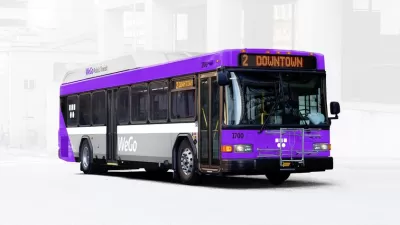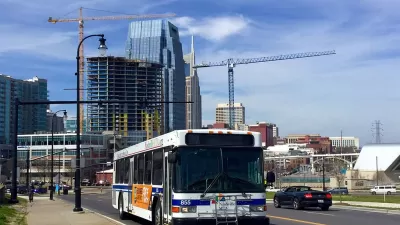Booming development and shifting demographics are driving updates to Music City’s land use policies. Civic leaders and planners say they want residents to steer the process, which has meant getting people’s attention in some unlikely ways.
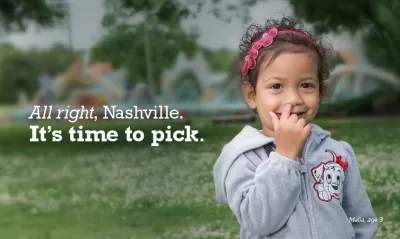
When my agency, MP&F Public Relations, took on the community outreach duties for Nashville’s General Plan update, we knew that—like any public planning process—it would require a lot of meetings.
I’m not sure they counted on us making sure it included kids picking their noses.
We’re now 20 months into our 30-month timeline for public outreach for NashvilleNext, the city’s first general plan update in 25 years. Like several cities our size, Nashville has undertaken a participatory, educational process that gives a great overview of the factors planners consider and how they arrive at their final recommendations and guidelines.
But it’s how Nashville has gone about it this time that has been so interesting. For perhaps the first time, the city has embraced a comprehensive planning process that has been partly pie-in-the-sky, partly pragmatic, and even a little irreverent. (All while another planning process, this one for Nashville’s first bus rapid transit line, has not gone so smoothly.)
It’s no secret that the city’s last general plan update, way back in 1992, didn’t quite hit the mark. That plan predicted unmitigated suburban boom, which was accurate … until the city started booming, too. Urban neighborhoods were mentioned, but their design and character was left to subsequent planning processes.
The plan’s development also wasn’t the most public process, resulting in something that looked a lot more like a thesis than a blueprint: plenty of theory, but not a whole lot of direction from actual Nashvillians. (The plan even acknowledges early on that “greatly improved opportunities for public access to the planning process in Nashville are needed.”)
It was a different time, of course. Nashville-Davidson County had 110,000 fewer people; nearly three-fourths of them were white. Country music was always king, of course, but professional sports teams were just a dream, the city’s health care boom was still on the horizon, and Nashville was known most embarrassingly for a mayor who had gone on The Phil Donahue Show to discuss his sex life with his nightclub singer fiancé (whom he was engaged to while still married to his third wife).
These days, Nashville looks a lot more like Hayden Panettiere’s version than Robert Altman’s. The city’s diverse economy, anchored by entertainment, health care and a growing creative class, sustained it through the worst of the recession. Now, Nashville’s on just about every “hot” list you can imagine; our convention and visitors corporation even made a video about it.
But there’s a lot more going on behind the glamour of Jack White, Kings of Leon and, er, Ke$ha. Nashville’s demographics are changing rapidly in ways never seen before. By 2040, the Nashville MSA is expected to grow by more than 1 million people, more than 200,000 of whom will live in Nashville-Davidson County. We’ll have three counties the size of Davidson today.
And those people will look much different than even the Nashvillians of today. If trends hold, by 2040, Nashville won’t have an ethnic majority. The city has the largest Kurdish population in the nation. The number of foreign-born residents has doubled in the past decade to 12 percent of the population. (In 2012, Nashville had the fastest-growing immigrant population of any U.S. city.) In Nashville schools, students speak 106 different languages.
Nashville’s consolidated city-county government creates another outreach challenge: geography. The county measures 526 square miles. As New York City Parks Commissioner Mitchell Silver told us last year, based on each city’s population density, you could fit the people of New York City, Philadelphia, and San Francisco into Davidson County. We’re big, sprawling, and congested, with some of the worst traffic in the nation.
So amid all these challenges, city leaders tasked the Planning Department and our agency with including as many Nashvillians as possible in NashvilleNext, and to do so in a diverse, inclusive, and instructive way. We did it by hitting the streets, setting up everywhere from grocery stores to nightclubs. We conducted outreach in six different languages, and even recruited volunteers to pass out surveys during the Mexican consul’s weeklong visit last September.
Through the first three phases of the project, we were wildly successful: More than 10,000 participants provided 15,200 inputs, outpacing Austin’s recent planning process by more than 50 percent (from a population that’s 30 percent smaller). Participation was reflective of U.S. Census percentages regarding age, race/ethnicity, foreign-born populations, and geographic representation.
But going into the last public phase this summer, we knew Nashvillians weren’t immune to dreaded “planning fatigue.” This phase, a culmination of the previous three, is the most intense yet in terms of time, material, and information. We had to take a 12-page tabloid’s worth of material and condense it into a single page, so that people could carry it with them or complete it onsite at a meeting.
We also needed a new theme to draw residents in just long enough to know that we still needed them to participate. And we were doing it with a practically nonexistent advertising budget; the total budget for NashvilleNext has been about 20 percent of what it would cost an outside firm to conduct the process.
After trying to figure out what made this phase different, we settled on a single word: pick. All the other phases had been about what you’d do with Nashville in an ideal world, with no consideration of inherent limitations in financing, politics, or infrastructure. But now people had to choose from the scenarios they created. For the first time in the process, we were setting pretty strict parameters. Participants had to pick.
The planning department asked us to be creative, which isn’t something you hear a lot in a government process. We wanted people’s attention, and we had to make this phase feeldifferent, so we went with the most logical extension of the “pick” theme.
We told kids to pick their noses.
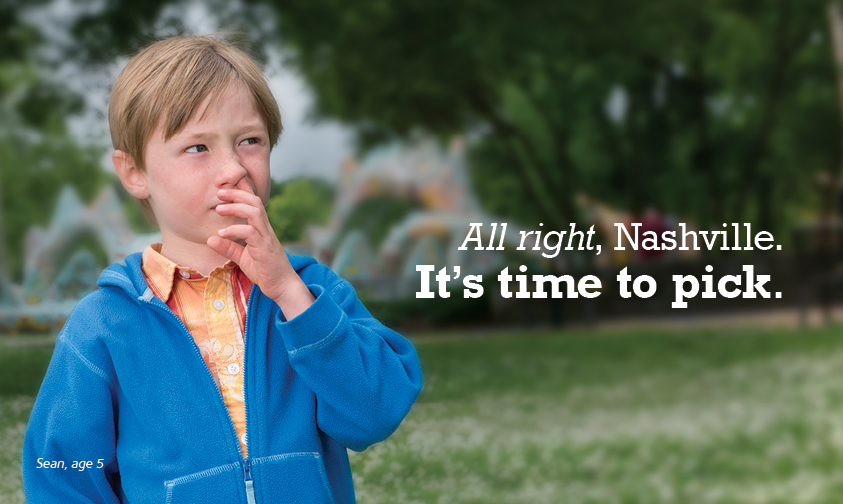
The results were pretty hilarious. We contacted friends and active residents who, strangely, were willing to go along with our request to plaster the city and the Internet with photos of their kids digging for gold. We set up in a well-known park on an overcast April day, and the kids got to picking. The process couldn’t have gone smoother; the kids had a blast, and the parents loved the candid shots we provided them for giving of their time.
There was, of course, the hurdle of actually getting the city to go along with it. We presented a pretty simple case: the kids, ages 1 to 6, are going to live with the results of NashvilleNext longer than any of our participants. The design of the neighborhoods they grow up in, the access to the parks they play in, the location of the schools they attend—all of it will be influenced directly by a plan they won’t have had any say in. We wanted to remind Nashville that this plan has an impact on a wide range of generations, even if we did it in a cute, goofy, and kinda icky way.
After a long vetting process that reached to the mayor’s office, and a promise to add photos of the same kids “picking” flowers and guitars, we were approved. The theme launched in June, and so far the participation results are tracking along those of our first phase—a remarkable achievement given we’ve battled summer vacations, the intensity of the information and the ubiquitous advertising of an election cycle.
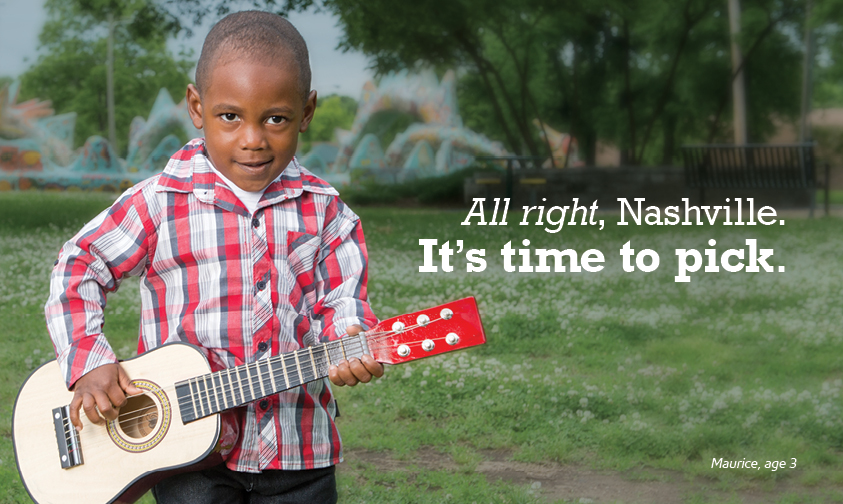
We’ve blanketed the city with Textizen posters of the kids, and we’re going on city buses and Facebook ads this month. Social media awareness is up 10 percent, with no advertising. By summer’s end, we will have conducted nearly 40 public events and meetings across the county before planners head back out in the fall to explain how NashvilleNext affects smaller community plans.

The success of NashvilleNext wouldn’t be possible without Nashville’s planners, who staff what has to be one of the hardest-working planning departments in the country. In the midst of a development boom and bevy of overlay studies, zoning changes, and Specific Plan requests, Executive Director Rick Bernhardt’s staff has manned more than 150 NashvilleNext public events and an untold number of internal strategy and analysis meetings.
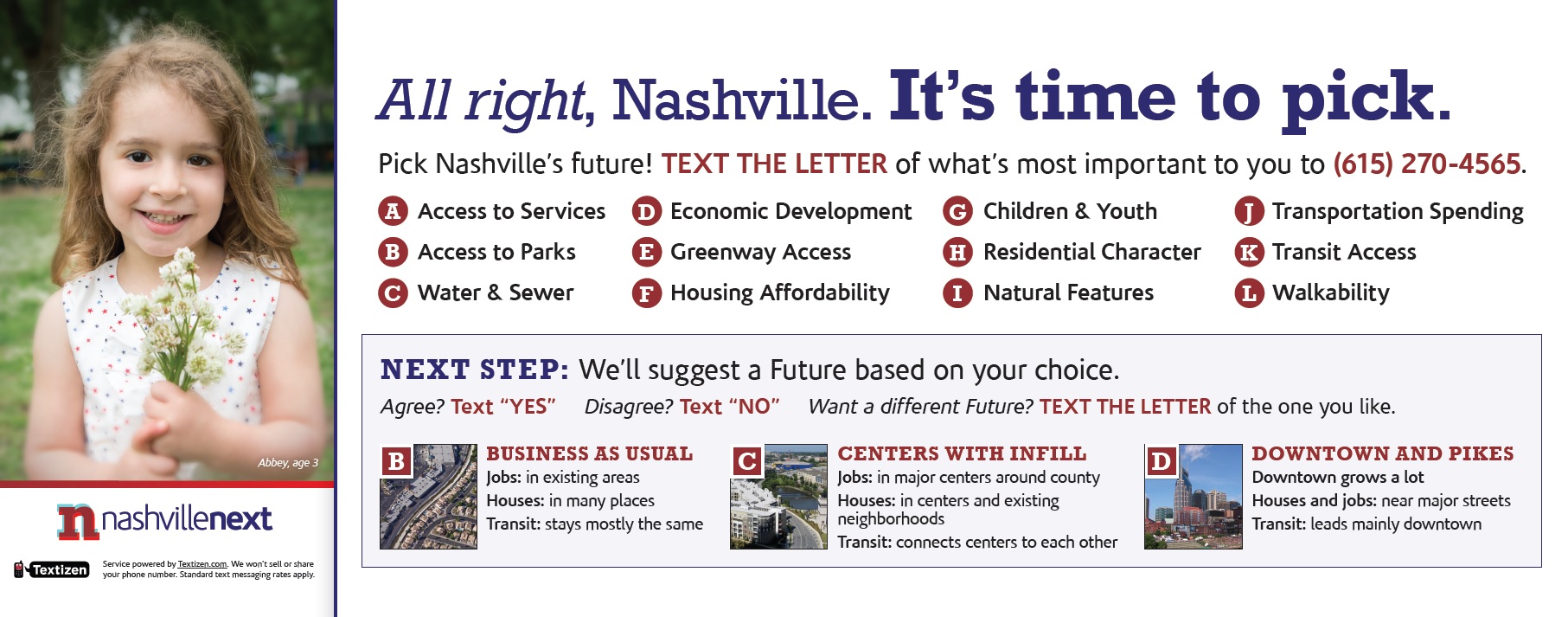
Community volunteers from across the city and county have committed two years’ worth of public engagement efforts, and policy experts have given additional direction through resource teams addressing everything from arts to water and sewer infrastructure. Businesses, nonprofits, and other Metro Nashville government departments have been incredibly generous with their time and resources (by the time we finish, we’ll seemingly have been in every meeting space in the county).
Nashville’s willingness to embrace the planning process can only mean good things for the city’s future. Now more than ever, Nashville’s citizens are learning about the tools and resources available to determine where and how the city grows. The participation of residents will, in turn, keep elected officials accountable when a new mayor takes office next year, right after the plan is adopted. By that time, we hope to have a plan that will meet the future needs of the Nashvillians who we’re asking to pick flowers, guitars, and their noses now.
Colby Sledge is a senior account executive at MP&F Public Relations in Nashville and is the lead community outreach consultant for NashvilleNext. He can be reached at [email protected].

Planetizen Federal Action Tracker
A weekly monitor of how Trump’s orders and actions are impacting planners and planning in America.

Maui's Vacation Rental Debate Turns Ugly
Verbal attacks, misinformation campaigns and fistfights plague a high-stakes debate to convert thousands of vacation rentals into long-term housing.

Restaurant Patios Were a Pandemic Win — Why Were They so Hard to Keep?
Social distancing requirements and changes in travel patterns prompted cities to pilot new uses for street and sidewalk space. Then it got complicated.

In California Battle of Housing vs. Environment, Housing Just Won
A new state law significantly limits the power of CEQA, an environmental review law that served as a powerful tool for blocking new development.

Boulder Eliminates Parking Minimums Citywide
Officials estimate the cost of building a single underground parking space at up to $100,000.

Orange County, Florida Adopts Largest US “Sprawl Repair” Code
The ‘Orange Code’ seeks to rectify decades of sprawl-inducing, car-oriented development.
Urban Design for Planners 1: Software Tools
This six-course series explores essential urban design concepts using open source software and equips planners with the tools they need to participate fully in the urban design process.
Planning for Universal Design
Learn the tools for implementing Universal Design in planning regulations.
Heyer Gruel & Associates PA
JM Goldson LLC
Custer County Colorado
City of Camden Redevelopment Agency
City of Astoria
Transportation Research & Education Center (TREC) at Portland State University
Jefferson Parish Government
Camden Redevelopment Agency
City of Claremont


























